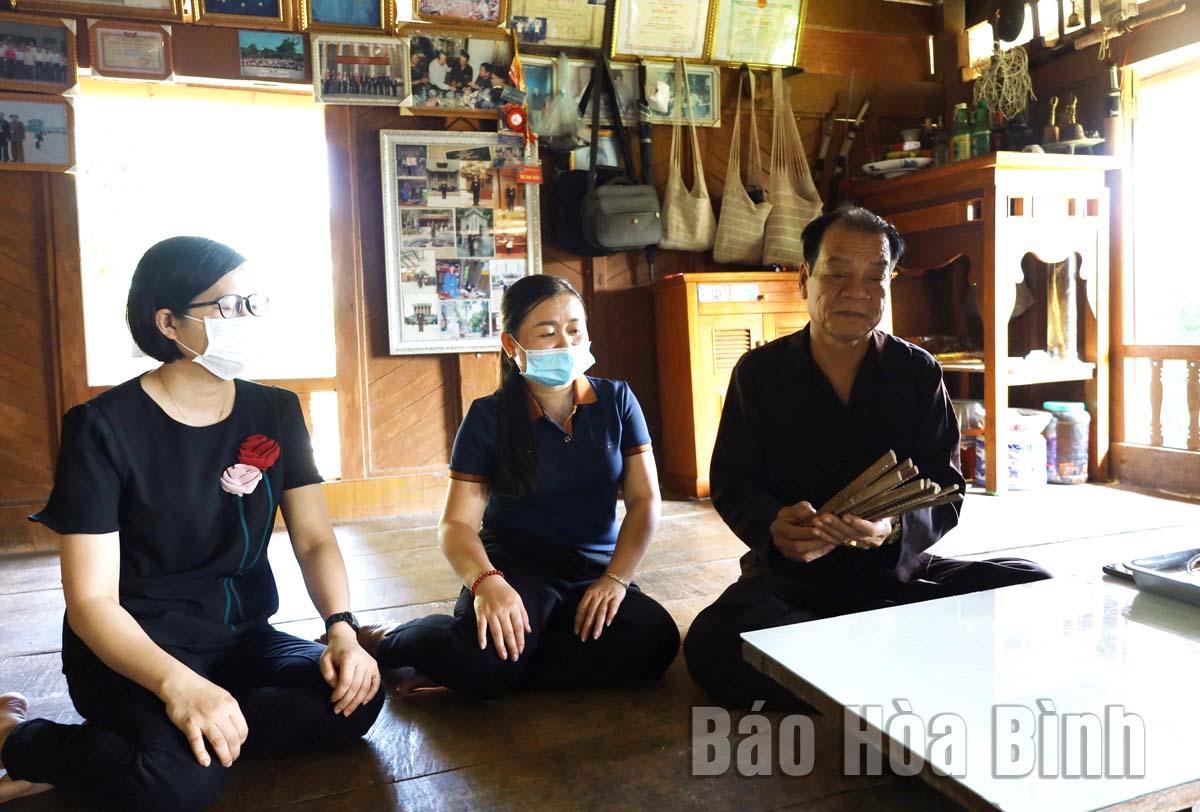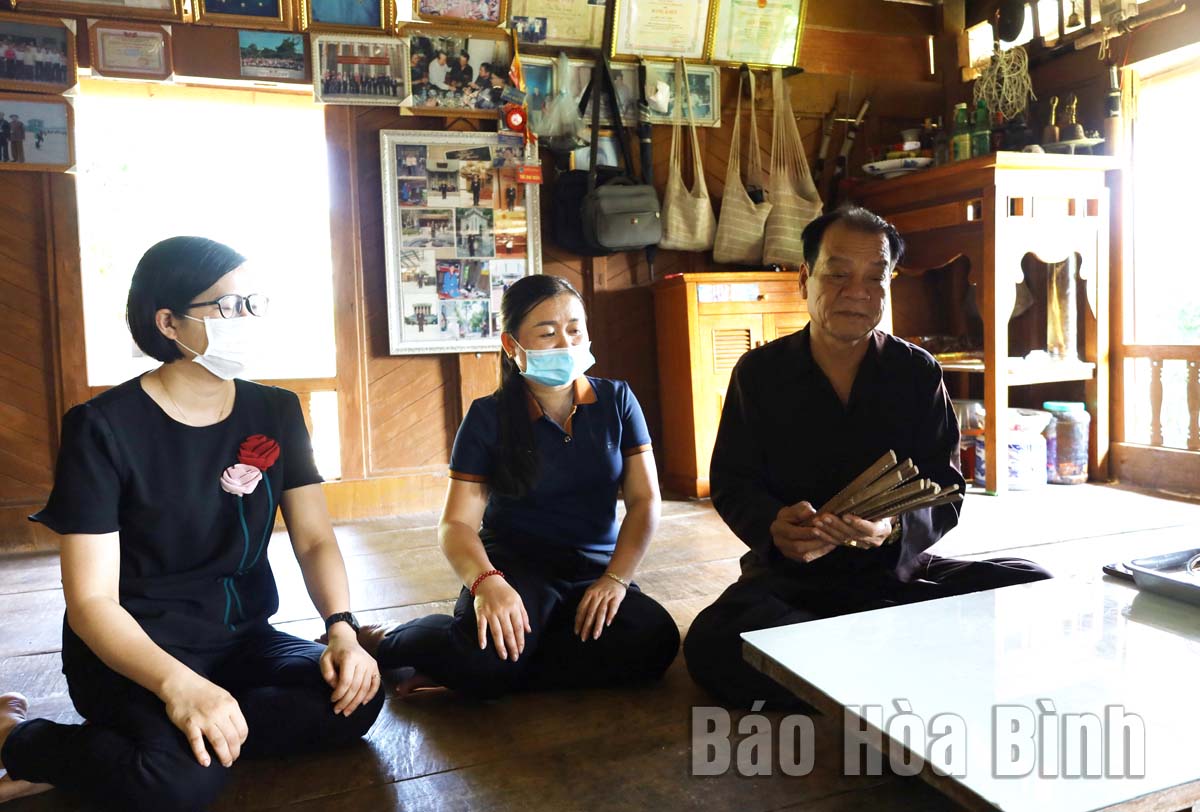
(HBO) – Coming into being very early in the history of the Muong ethnic group and containing unique values, the bamboo calendar, called Doi or Roi calendar, of Muong people in Hoa Binh province was recently honoured as part of the national intangible cultural heritage. Basing on the time division in a year and the movement of the moon and stars, local residents discovered and have applied the rule of the nature to their daily life.
Photo: Mo artisan Bui Van Lung in Phong Phu commune, Tan Lac district,
uses the bamboo calendar to forecast good days for local people’s affairs.
Bui Van Lung, a Mo Muong artisan in Muong Lam
hamlet of Phong Phu commune (Tan Lac district), said that the bamboo calendar
plays a special role in the life of the Muong community and also forms a
priceless treasure of folk knowledge. Aside from the popular Western calendar,
all production and daily activities, as well as customs, rituals, festivals and
important events of each person and family in the Muong community in Hoa Binh,
are based on the bamboo calendar.
The calendar comprises 12 carefully made bamboo
bars which are inscribed with notches, lines, and holes called symbols that
represent days, months, and natural phenomena in a month.
The bars are inscribed with 30 notches
representing 30 days in a lunar month.The days from the 1st to the 10th
are called "cay” days, the 11th to 20th "long” day, and the21st to 30th
"cuoi” days. Muong people often hold important events on the first days ("cay”
days) of a month.
At present, apart from being used in the community,
the bamboo calendar is also kept at the Muong Cultural Space Museum and the
private Museum of the Muong Culture in Hoa Binh city to preserve and introduce
it to local residents and visitors from far and wide.
Artisan Bui Thanh Binh, a researcher of the
Muong ethnic culture, said that the calendar is the quintessence built up over
many generations of Muong people and also a typical demonstration of the Muong
- Viet people’s consciousness of the world, obtained through their observation
of the movement of the moon and the Doi (Roi) constellation.
Until the late 20th century, the bamboo calendar
was still used across the areas of Muong people. Nowadays, there remain five
ancient sets of the bamboo calendar dating back hundreds of years and more than
100 new ones being used in the community in Hoa Binh province.
Together with the Khai Ha Festival, the bamboo
calendar of Muong people in Hoa Binh was recognised as part of the national
intangible cultural heritage in 2022.
Luu Huy Linh, Deputy Director of the provincial
Department of Culture, Sports and Tourism, held that it is necessary to enhance
the bamboo calendar preservation, step up communications and research to teach
locals in how to apply it to their daily life, and make use of the calendar and
other special cultural heritage pieces to develop tourism./.
With an increasingly vibrant and widespread emulation movement aimed at building cultured residential areas and cultured families, Yen Thuy District has been making steady progress toward improving both the material and spiritual well-being of its people, while fostering a civilized, prosperous, beautiful, and progressive community.
Once lacking recreational spaces and community facilities, Residential Group 2 in Quynh Lam Ward (Hoa Binh City) has recently received attention for the construction of a new, spacious, and fully equipped cultural house. The project followed the model of state support combined with public contributions in both labor and funding.
The "All people unite to build cultural life" movement, which has been effectively integrated with Kim Boi district’s socio-economic development goals, is fostering a lively spirit of emulation across local residential areas, hamlets, villages, public agencies, and enterprises. In addition, through the initiative, traditional cultural values are being preserved and promoted, while community solidarity and mutual support in poverty reduction and economic development are being strengthened.
A working delegation of the Hoa Binh provincial People’s Committee led by its Permanent Vice Chairman Nguyen Van Toan on June 11 inspected the progress of a project to build the Mo Muong Cultural Heritage Conservation Space linked to tourism services in Hop Phong commune, Cao Phong district.
Born and growing in the heroic land of Muong Dong, Dinh Thi Kieu Dung, a resident in Bo town of Kim Boi district, in her childhood was nurtured by the sweet lullabies of her grandmother and mother. These melodies deeply imprinted on her soul, becoming an inseparable part of her love for her ethnic group's culture. For over 20 years, this love for her hometown has driven Dung to research, collect, and pass down the cultural values of the Muong people to future generations.
In the final days of May, the Ethnic Art Troupe of Hoa Binh Province organized performances to serve the people in remote, mountainous, and particularly disadvantaged areas within the province. These were not just ordinary artistic shows, but they were the meaningful journeys aimed at spreading cultural values, enhancing the spiritual life of the people and contributing to the preservation of ethnic minority cultural identities.



